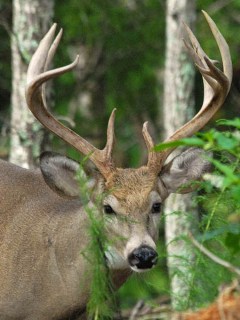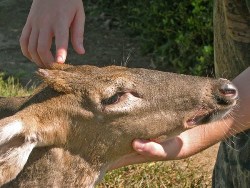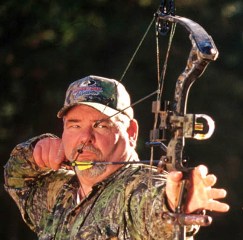John Phillips | November 04, 2010
 “Most hunting clubs and landowners can't manage their deer herds properly because they have made button bucks sacred cows," says Corky Pugh, chief of the Wildlife Section of Alabama's Department of Conservation. Many hunters have become so afraid of shooting button bucks that they won't take the number of does they need to harvest to keep their herds healthy. In hunting clubs, sportsmen often face severe penalties if they mistakenly shoot button bucks instead of does. An outdoorsman's risking the possibility of having to pay a heavy fine or perhaps having his hunting club expel him when he shoots a doe and later discovers he's bagged a button buck often means hunters will refuse to harvest the number of unantlered deer they need to remove from their property. In many sections of the country, button bucks have created more of a management problem than the does have.
“Most hunting clubs and landowners can't manage their deer herds properly because they have made button bucks sacred cows," says Corky Pugh, chief of the Wildlife Section of Alabama's Department of Conservation. Many hunters have become so afraid of shooting button bucks that they won't take the number of does they need to harvest to keep their herds healthy. In hunting clubs, sportsmen often face severe penalties if they mistakenly shoot button bucks instead of does. An outdoorsman's risking the possibility of having to pay a heavy fine or perhaps having his hunting club expel him when he shoots a doe and later discovers he's bagged a button buck often means hunters will refuse to harvest the number of unantlered deer they need to remove from their property. In many sections of the country, button bucks have created more of a management problem than the does have.
A couple of years ago wildlife biologists had determined that to maintain a healthy deer herd on a 30,000-acre property, the landowner needed to harvest 400 does per year. The landowner asked all the hunters to concentrate on taking does. However, he also imposed a $500 fine on anyone who shot a button buck. Sitting beside a green field one afternoon, a hunter watched 15 to 20 deer out in the green field, while studying the biggest doe about 70-yards away carefully for about an hour with his binoculars. As the sun faded away, the hunter made the decision to bag this doe. Before he could get his rifle up to take a shot, he spotted a fawn that came out of high grass, went up to the doe and apparently begin to nurse. Now certain of this deer's sex, he knew he should harvest the doe because all the fawns had just about disappeared. When the fawn left, he prepared to shoot. But just before he pushed the safety off, he got an eerie feeling that something didn't add up, held his shot and waited for the doe to feed closer. Finally the doe came to within 15 steps of his shooting house. Once again he took his binoculars and studied the doe's head. That’s when he spotted two, wart-sized bumps just below the hairline that hadn't broken through the skin yet. He couldn't determine why a button buck disguised as a doe stood still and let the fawn come up to it and pretend to nurse. Everything the hunter knew about does at the time screamed, "This is a doe," and he knew he should take her. But, if he had squeezed the trigger on that "doe," he realized he’d have had to pay $500 for shooting a button buck.
You'll find having to pay money is not the only problem associated with bagging button bucks. A young friend, John, a very-good hunter who had taken several nice bucks, decided to shoot a doe after looking her over carefully. The doe went down quickly. But when John went up to her to claim his meat for the table, he discovered he'd shot a button buck. He told me he considered the shame and embarrassment he suffered far worse than any fine he'd have to pay. He almost quit hunting because of having shot a button buck instead of a doe.
A couple of years ago, another young hunter, bagged his first deer after a hunt manager asked him to take only does unless he spotted a nice buck with 8 points or better. Although Jason used his binoculars to look the doe over carefully before he took the shot, when he approached his downed doe, he discovered that the animal had two buttons under the hairline that he hadn't seen with the binoculars. Both Jason and John took button bucks on lands where the deer had plenty of food, and young bucks might weigh more than 100 pounds before their antlers broke through the skin. Each of these young men felt guilty and ashamed for having mistakenly shot button bucks.
"I think hunting clubs and private lodges are really making a mistake by financially penalizing and embarrassing hunters when they accidentally shoot button bucks when they think they're taking does," Corky Pugh, chief of the Wildlife Section of Alabama's Department of Conservation, states. "If you're going to harvest the number of does that most properties, particularly across the South, must remove to keep their herds in balance, you’ll bag some button bucks. That’s just a fact."
Button Bucks and Herd Dynamics
 On many public lands and state wildlife-management areas, biologists consider and count button bucks as part of the antlerless deer harvest. These professionals recognize the difficulty of determining a button buck from a doe. But how many button bucks do landowners and hunting camps actually lose? A fact sheet prepared by Curt Thiede of the Bureau of Wildlife Management and Robert Rolley with the Bureau of Integrated Science Services for Wisconsin's Department of Natural Resources states that, "Between 1964 and 2000, Wisconsin's Department of Natural Resources aged 257,920 antlerless deer. On average, buck fawns comprised 21.6 percent, doe fawns 17.4 percent, adult does 59.4 percent, and sub-legal adult bucks 1.6 percent of the antlerless deer aged. The percentage of buck fawns in the harvest tends to be slightly lower than the percentage of buck fawns in the fall population due to the hunters' desire to harvest an adult deer. For example, the estimated composition of the 2000 fall population of the antlerless deer was about 50 percent adult does, 26 percent buck fawns and 24 percent doe fawns. During these 37 years, the percentage of buck fawns taken in the gun harvest remained fairly stable, despite substantial variation in the antlerless harvest.”
On many public lands and state wildlife-management areas, biologists consider and count button bucks as part of the antlerless deer harvest. These professionals recognize the difficulty of determining a button buck from a doe. But how many button bucks do landowners and hunting camps actually lose? A fact sheet prepared by Curt Thiede of the Bureau of Wildlife Management and Robert Rolley with the Bureau of Integrated Science Services for Wisconsin's Department of Natural Resources states that, "Between 1964 and 2000, Wisconsin's Department of Natural Resources aged 257,920 antlerless deer. On average, buck fawns comprised 21.6 percent, doe fawns 17.4 percent, adult does 59.4 percent, and sub-legal adult bucks 1.6 percent of the antlerless deer aged. The percentage of buck fawns in the harvest tends to be slightly lower than the percentage of buck fawns in the fall population due to the hunters' desire to harvest an adult deer. For example, the estimated composition of the 2000 fall population of the antlerless deer was about 50 percent adult does, 26 percent buck fawns and 24 percent doe fawns. During these 37 years, the percentage of buck fawns taken in the gun harvest remained fairly stable, despite substantial variation in the antlerless harvest.”
The conclusions from this intensive study showed that:
- Buck fawns comprised 21.6 percent of the antlerless harvest from the 1964 to the 2000 gun season with very little annual variation. The percentage of buck fawns in the harvest was similar to that of the fall population.
- The number of buck fawns taken increased as the annual deer harvest increased. However, the percentage basis shows that buck fawns still comprised between 20 and 25 percent of the harvest.
- Aging data provided an excellent record of buck fawn harvest.
- Wisconsin's buck fawn harvest was very similar to that of other Midwestern states.
- Buck-fawn harvests, in special deer seasons, were very similar to regular deer-season harvests.”
In other words, the Wisconsin study tends to indicate that if you shoot antlerless deer as a means of deer-herd-management control, you will lose 21 to 25 percent of the button bucks on your property each year. This fact horrifies many deer hunters who try to raise more and bigger bucks. However, this statistic also means that does will make up 75 to 78 percent of the deer harvested during antlerless hunting. Taking off the prescribed number of does is much-more important and vital to the health of your deer herd than losing a few bucks. You must harvest the recommended number of does to keep the herd in balance, less susceptible to parasites and dynamic and to prevent range destruction. According to data received from other Midwestern states, Wisconsin’s buck-fawn harvest is similar to that of other states. During the 1990s, Wisconsin’s buck-fawn harvest averaged 22.5 percent of the antlerless harvest, whereas Illinois, Minnesota and Indiana had average percentages of 26.7 percent, 19.7 percent and 24.8 percent, respectively.
Unhealthy Side Effects of Fearing the Button
 Although you can stockpile cordwood, you can't stockpile deer from year to year. A healthy deer herd has the genetic potential to double every year. If one buck breeds one doe, and that doe drops two fawns that survive, then the deer herd has doubled in size from two to four in one year. Too, when you consider that on many deer leases and public lands, one buck will breed more than one doe, you easily can understand why a region can have an overpopulated deer herd very quickly. In most areas of the U.S., to keep a healthy deer herd with plenty of food for them to eat, someone must remove a certain number of unantlered deer from each property. If you don't harvest those antlerless deer, your herd will grow out of balance rapidly. You'll see range destruction and a large amount of parasites and disease that result in deer with poor health. You defeat the goals of good deer management - keeping a healthy deer herd and removing the number of antlerless deer you need to take off your property - when you penalize hunters for unknowingly shooting button bucks.
Although you can stockpile cordwood, you can't stockpile deer from year to year. A healthy deer herd has the genetic potential to double every year. If one buck breeds one doe, and that doe drops two fawns that survive, then the deer herd has doubled in size from two to four in one year. Too, when you consider that on many deer leases and public lands, one buck will breed more than one doe, you easily can understand why a region can have an overpopulated deer herd very quickly. In most areas of the U.S., to keep a healthy deer herd with plenty of food for them to eat, someone must remove a certain number of unantlered deer from each property. If you don't harvest those antlerless deer, your herd will grow out of balance rapidly. You'll see range destruction and a large amount of parasites and disease that result in deer with poor health. You defeat the goals of good deer management - keeping a healthy deer herd and removing the number of antlerless deer you need to take off your property - when you penalize hunters for unknowingly shooting button bucks.
Honestly, no one really wants to shoot a button buck. In an antlerless deer harvest, hunters strive to shoot does. However, hunters will mistake some antlerless or button bucks for does. Biologists and many longtime hunters don't believe in punishing the hunter or making him feel guilty when this happens. Fining and/or embarrassing hunters when they shoot button bucks will keep hunters from harvesting the number of unantlered deer they need to take to keep the deer herd healthy and viable.
Biologists suggest you consider taking this approach to the button-buck issue. Before hunting season, at the annual hunting-club or lease meeting, explain to all the hunters that . . .
- A certain number of unantlered deer must come off the property. Ask each of the hunters to participate in the unantlered harvest, according to the prescription for your land and/or state regulations.
- Hunters may mistakenly harvest some button bucks for does. Do encourage hunters to try to bag only does. But mention that no one will penalize anyone or make him feel guilty who takes a button buck.
- Button bucks will make up 21 to 25 percent of the number of unantlered deer taken. Also emphasize they must take this number of button bucks to remove the number of unantlered deer the camp, the lease or the lodge must eliminate for the herd’s health.
Remember, if you make the button buck the sacred cow of your deer lease, more than likely, you will hurt your deer herd rather than help it. By giving up a small percentage of button bucks each season, your deer herd can and will produce more, bigger and better bucks year after year.






























